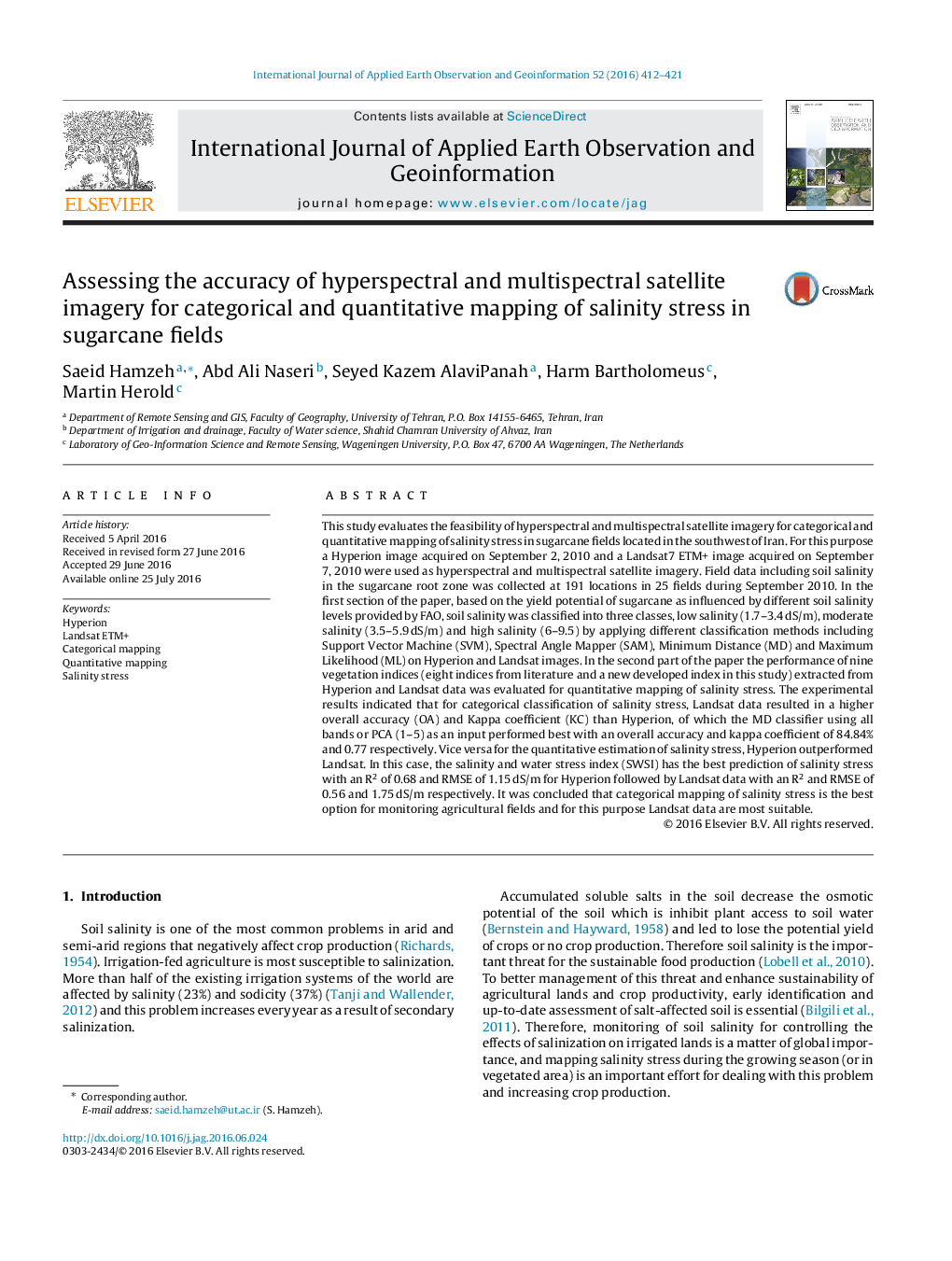| کد مقاله | کد نشریه | سال انتشار | مقاله انگلیسی | نسخه تمام متن |
|---|---|---|---|---|
| 6348501 | 1621805 | 2016 | 10 صفحه PDF | دانلود رایگان |
عنوان انگلیسی مقاله ISI
Assessing the accuracy of hyperspectral and multispectral satellite imagery for categorical and Quantitative mapping of salinity stress in sugarcane fields
ترجمه فارسی عنوان
ارزیابی صحت تصاویر ماهواره ای هیپرتشکل و چندمتغیره برای تطبیق قطعی و کمی تنش شوری در مزارع نیشکر
دانلود مقاله + سفارش ترجمه
دانلود مقاله ISI انگلیسی
رایگان برای ایرانیان
کلمات کلیدی
موضوعات مرتبط
مهندسی و علوم پایه
علوم زمین و سیارات
کامپیوتر در علوم زمین
چکیده انگلیسی
This study evaluates the feasibility of hyperspectral and multispectral satellite imagery for categorical and quantitative mapping of salinity stress in sugarcane fields located in the southwest of Iran. For this purpose a Hyperion image acquired on September 2, 2010 and a Landsat7 ETM+ image acquired on September 7, 2010 were used as hyperspectral and multispectral satellite imagery. Field data including soil salinity in the sugarcane root zone was collected at 191 locations in 25 fields during September 2010. In the first section of the paper, based on the yield potential of sugarcane as influenced by different soil salinity levels provided by FAO, soil salinity was classified into three classes, low salinity (1.7-3.4Â dS/m), moderate salinity (3.5-5.9Â dS/m) and high salinity (6-9.5) by applying different classification methods including Support Vector Machine (SVM), Spectral Angle Mapper (SAM), Minimum Distance (MD) and Maximum Likelihood (ML) on Hyperion and Landsat images. In the second part of the paper the performance of nine vegetation indices (eight indices from literature and a new developed index in this study) extracted from Hyperion and Landsat data was evaluated for quantitative mapping of salinity stress. The experimental results indicated that for categorical classification of salinity stress, Landsat data resulted in a higher overall accuracy (OA) and Kappa coefficient (KC) than Hyperion, of which the MD classifier using all bands or PCA (1-5) as an input performed best with an overall accuracy and kappa coefficient of 84.84% and 0.77 respectively. Vice versa for the quantitative estimation of salinity stress, Hyperion outperformed Landsat. In this case, the salinity and water stress index (SWSI) has the best prediction of salinity stress with an R2 of 0.68 and RMSE of 1.15Â dS/m for Hyperion followed by Landsat data with an R2 and RMSE of 0.56 and 1.75Â dS/m respectively. It was concluded that categorical mapping of salinity stress is the best option for monitoring agricultural fields and for this purpose Landsat data are most suitable.
ناشر
Database: Elsevier - ScienceDirect (ساینس دایرکت)
Journal: International Journal of Applied Earth Observation and Geoinformation - Volume 52, October 2016, Pages 412-421
Journal: International Journal of Applied Earth Observation and Geoinformation - Volume 52, October 2016, Pages 412-421
نویسندگان
Saeid Hamzeh, Abd Ali Naseri, Seyed Kazem AlaviPanah, Harm Bartholomeus, Martin Herold,
